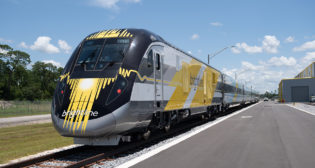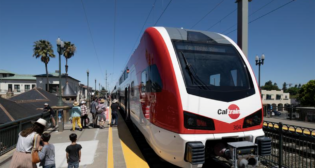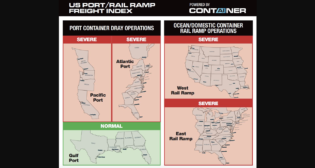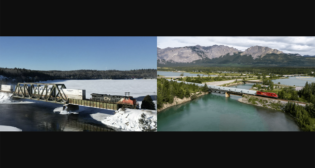
Regional Railroad of the Year
Written by AdministratorReading & Northern: Ready and able
U.S. energy options in the coming decades will need to be plentiful and diverse. Count on the Reading & Northern Railroad to contribute to any solution.
Energy drives the Reading & Northern Railroad Co.—from without and from within. Sporting the moniker “The Road of Anthracite,” the R&N aggressively serves U.S. energy demand through its movement of coal and its contributions to the rapidly growing hydraulic fracturing (“fracking”) natural gas market in Pennsylvania, with both markets likely to grow in the years ahead.
But it’s not just the energy moved by 572 open hoppers, 40 Western coal cars, 250 covered hoppers, or 11 gondolas across 320 route-miles that make R&N move, according to President Wayne Michel. To accomplish its goals, it partners with other regional railroads, short lines, and Class I’s.
It’s also the human energy of the railroad’s roughly 150 full-time employees, and a company commitment to job security that withstood even the Great Recession in 2009. “We don’t like to let good people go,” Michel asserts. “Morale is huge for us.”
The continuous excellence pursued by Pennsylvania’s largest privately owned regional railroad, in operation since 1983, has garnered it Railway Age’s 2011 Regional Railroad of the Year award.
It’s not the first time the Reading & Northern has been recognized for drive. The regional railroad was a winner of the 2010 American Short Line and Regional Association Marketing Awards Competition—“a great honor,” according to CEO Andrew M. Muller, Jr. Railway Age previously honored the Reading & Northern as its 2002 Regional Railroad of the Year, and the award is featured among other citations on the wall of the railroad’s headquarters (and station building) in Port Clinton, Pa.
But don’t expect the railroad to rest on the laurels captured during its first 26 years. “On to the next one,” quipped one company executive, not unkindly, concerning the railroad’s latest honor, indicating awards were a marker of the company’s energy and drive—but not the goal.
Coal still contributes mightily
Indeed, “energy” is and may be a big component of the railroad’s future, much as it has been in the past. “The Road of Anthracite” isn’t just a nod to what was, but reflects a growing business segment, as Asian demand for anthracite begins to strain Asian resources. Reading & Northern, tapping that market demand, has seen anthracite grow from 15% of its business to 23% in 2010. But problems arose in 2008 when such exports, traditionally routed through the Port of Baltimore, were turned away due to port capacity constraints. Nearby ports in Fairless Hills, Pa., and Wilmington, Del., picked up the slack—by truckload.
Reading & Northern quickly entered discussions with port operators Kinder Morgan, in Fairless Hills, and Port Contractors, in Wilmington, and though export coal demand withered in 2009, discussions resumed last year to seek a rail alternative.
The two port operators chose Rail Barge Truck Services (RBT) of Elizabethtown, Ky., in developing a plan to employ large portable undercar conveyors that could move along a string of railcars to handle coal loads. R&N committed to purchasing one unit for Fairless Hills and one for Wilmington.
R&N’s first unit train of coal was received by the Port of Fairless Hills last December, while Wilmington operations commenced last month. “We now have two new export anthracite facilities, and we made the initial investments,” stresses Michel, who anticipates the investment taking the equivalent of 4,000 trucks off the roads in 2011.
Natural gas prospects blossom
Michel is proud of the railroad’s willingness to invest strategically, backed by CEO Muller, even before the need might arise. R&N acquired 150 covered hopper cars for coal “when we didn’t yet have the business.”
About 80 of those cars now are involved in servicing the growing production of natural gas in the region, lying in Marcellus shale underground. Determined once more to be the economical alternative to truck traffic, R&N quickly positioned itself as a supplier of fracking sand and other commodities required for natural gas extraction. It reopened, rehabilitated, and expanded facilities on part of its 80-acre Pittston Yard facility (outside Scranton), and in concert with D&I Silica, put together a transload operation in a few weeks. “We like to make things happen,” Michel says, describing D&I Silica as the “perfect partner” due to its ability to act as a “neutral” party willing to buy and sell sand to all comers.
On Dec. 7, 2009, R&N held a ceremonial opening of its terminal to serve the natural gas business. “There were trucks already lined up for loading,” which commenced at 3:00 a.m. the next day, Michel says.
R&N helped convey 1,400 carloads of sand in its first year of operation, and offers 800 car spots, six times the number of any of the railroad’s competitors. It also offers twice-a-day switching service as a regularly scheduled option, with the capability of even more frequency given customer notice. Michel says nearly 50 acres remain for redevelopment at Pittston Yard, giving the railroad ample room to grow the business still more.
Other customers, other carriers
Energy sectors aside, Reading & Northern prides itself on a fairly diverse customer base, pointing to customers such as International Paper Co., AEP Industries, Inc., which receives large shipments of plastic pellets to produce packaging films, and consumer products giant Proctor & Gamble (which, as it happens, also has a natural gas well in operation on its Pennsylvania property. Pottsville, Pa.-based Yuengling Beer Co., “America’s Oldest Brewery,” has expansion plans in the works that will generate more business for the R&N.
R&N, serving eastern Pennsylvania, interchanges traffic with five other regional or short lines, as well as Norfolk Southern and Canadian Pacific. NS and CP each run one through train per day across R&N’s trunk line. More than 22,000 carloads were handled directly by the Reading & Northern in 2010—most of that interchanged with Norfolk Southern—in addition to more than 60,000 carloads of trackage rights business.
The railroad is ready for more. Right-of-way maintenance is taken seriously; Michel says the railroad has committed $7 million, a mix of its own funds and contributions from the state of Pennsylvania, to upgrade and improve conditions on its system. System capacity is more than adequate. Though R&N has double-tracked portions of its trunk line, stretching from Reading northeast to Scranton, it is eyeing to add more double-track this year by putting additional portions of its railroad back into service. “It’s on our radar,” Michel says.
Passenger excursions promote the railroad locally, and also generate about $1 million in annual revenue, Michel says. This year Reading & Northern plans to offer passenger trips for employees of its freight customers as requested—a public relations plus in showing customers just where the railroad reaches and what it can do.
CEO Andrew Muller notes any future use of the Reading & Northern by intercity, regional, or commuter passenger operators would be considered as another potential customer, presuming R&N’s interests can be kept whole. “We welcome the opportunity to participate and contribute,” says Muller—a contrast from some properties that see passenger operators not as a potential customer but as a problem.
Michel says at least five new development projects are occurring in the regional railroad’s territory, and R&N hopes and expects to serve them with its “mix of Class I efficiency and local flexibility matched to meet short line customer needs.” Those potential customers might check Reading & Northern’s existing clientele; if they do, they’ll discover that they’ll be hard-pressed to find a better transportation option.



